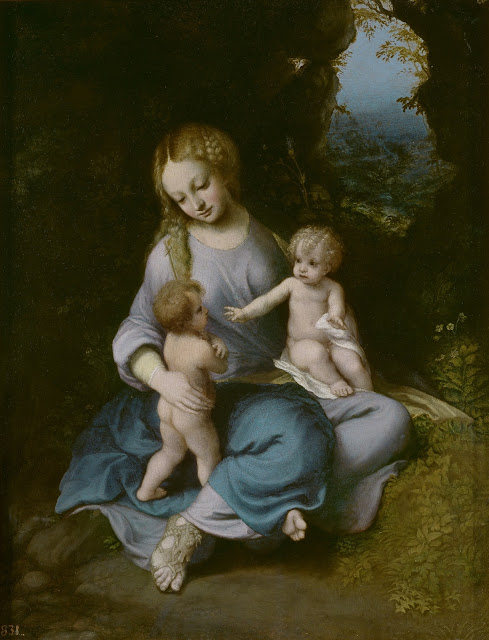 |
| Correggio Mystic Marriage of St Catherine ca. 1510-15 oil on panel National Gallery of Art, Washington DC |
 |
| Correggio The Nativity, with St Elizabeth and Infant St John the Baptist ca. 1512-13 oil on panel Pinacoteca di Brera, Milan |
 |
| Correggio Madonna and Child ca. 1512-14 oil on panel Kunsthistorisches Museum, Vienna |
 |
| Correggio Christ taking leave of His Mother before 1514 oil on canvas National Gallery, London |
 |
| Correggio Adoration of the Magi ca. 1515-18 oil on canvas Pinacoteca di Brera, Milan |
"In northern Italy there was no general movement that corresponded to the post-classical developments in Central Italy, but a few artists – in no sense a group; on the contrary, salient individualities – did accomplish in the third decade acts which, as much as those of their Florentine and Roman contemporaries, worked creative changes upon classical painting style. . . . The most profound of these innovators, and the subtlest spirit among them, was Antonio Allegri, Il Correggio. His origins and the chief places of his practice were provincial, yet he transcended them utterly to achieve a suavity and complexity of artistic utterance which alone in the whole extent of northern Italy of his time may be compared to that of the Venetian Titian. His place of birth, from which he takes his name, was the seat of a minuscule provincial court, not far east of Parma, the town where he was to spend the most important years of his mature career. . . . His birthplace had no role we can discern in his artistic education, which it is now clear must have taken place in Mantua at a time when, even if Mantegna might no longer have been alive, his direct school held the dominating place. There is no documented work by Correggio before late 1514, but approximately a dozen pictures survive that attest his activity during at least the three preceding years, from about 1511. The earliest of these are in a style of which the strongest evident component is its connexion, in motifs as well as in manner, with a Mantegnesque inheritance; but they are softer, touched with a sfumato that is not native to the older style. . . . Certain among these early works, dating from 1513-14, indicate a second aspect of Correggio's education: an experience that is almost – but not quite – provable of the Milanese work of Leonardo, and a likely contact with the earliest work in Bergamo of Lorenzo Lotto. . . . It is much more than a technique that Correggio has comprehended: he has fused this Leonardesque optical consistency with a consonance of vibrant, shadowed mood – what can only be described as a sfumato of emotion; this is a quality that Correggio was to retain in his art long after its specific precedent in Leonardo had been forgotten."
– S.J. Freedberg from Painting in Italy - 1500 to 1600 in the Pelican History of Art series (London, 1971)
 |
| Correggio Madonna and Child with St John the Baptist ca. 1515 oil on panel Art Institute of Chicago |
 |
| Correggio Salvator Mundi ca. 1515 oil on panel National Gallery of Art, Washington DC |
 |
| Correggio Saints Peter, Martha, Mary Magdalen and Leonard ca. 1515-17 oil on canvas Metropolitan Museum of Art. New York |
 |
| Correggio Madonna and Child with St John the Baptist ca. 1516 oil on panel Museo del Prado, Madrid |
 |
| Correggio Madonna Campori ca. 1517-18 oil on panel Galleria Estense, Modena |
 |
| attributed to Correggio Penitent Magdalen ca. 1518-19 oil on canvas National Gallery, London |
 |
| Correggio The Three Graces 1518-19 fresco in grisaille Camera di San Paolo, Parma |
 |
| Correggio Figure Study for The Three Graces ca. 1518 drawing British Museum |
 |
| Correggio Study of Angel for a Frieze ca. 1515 drawing Victoria & Albert Museum |